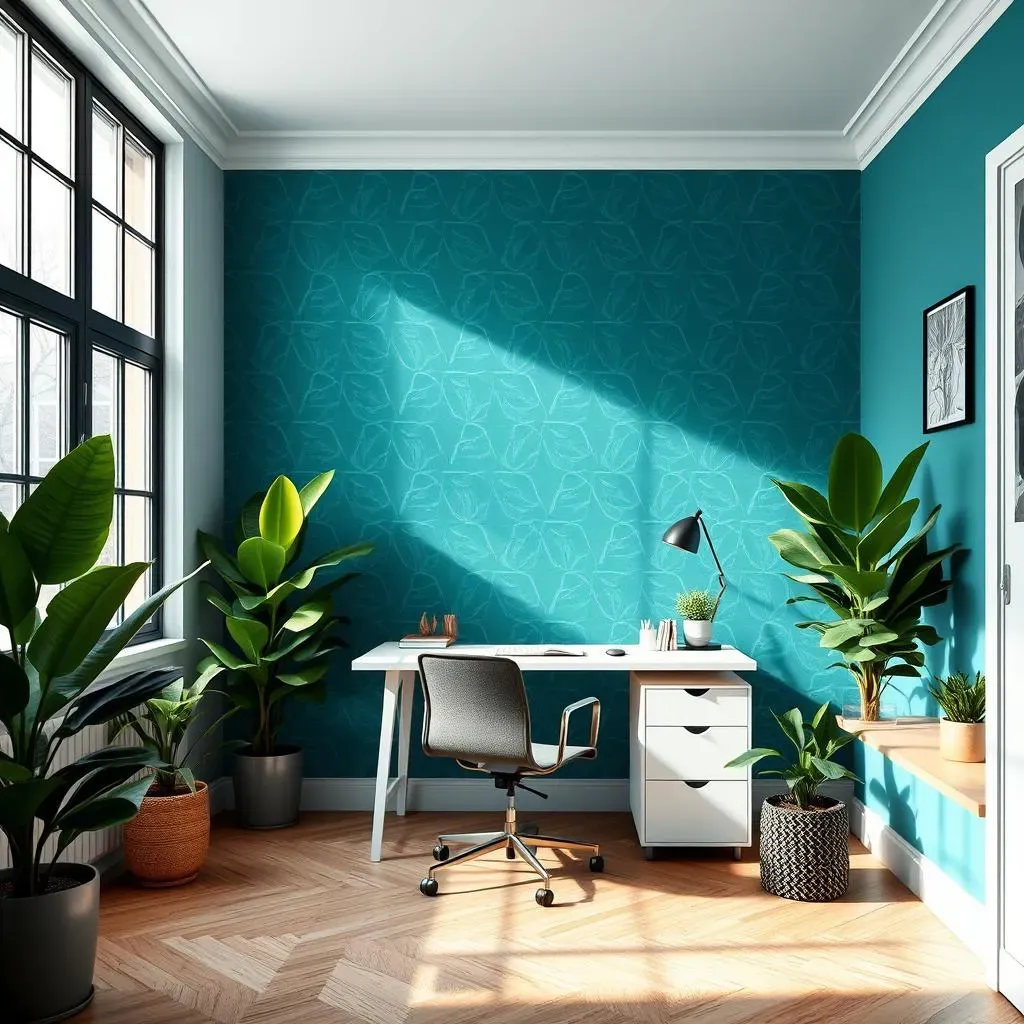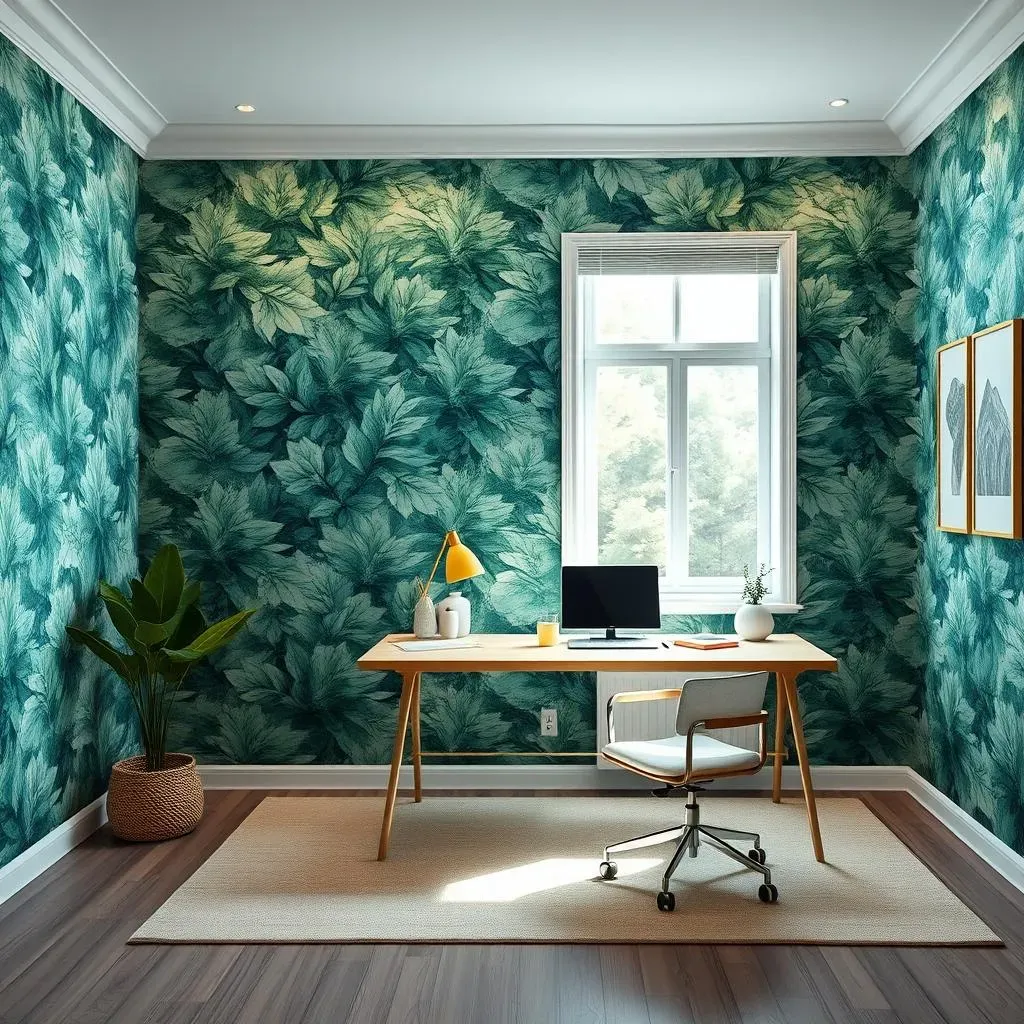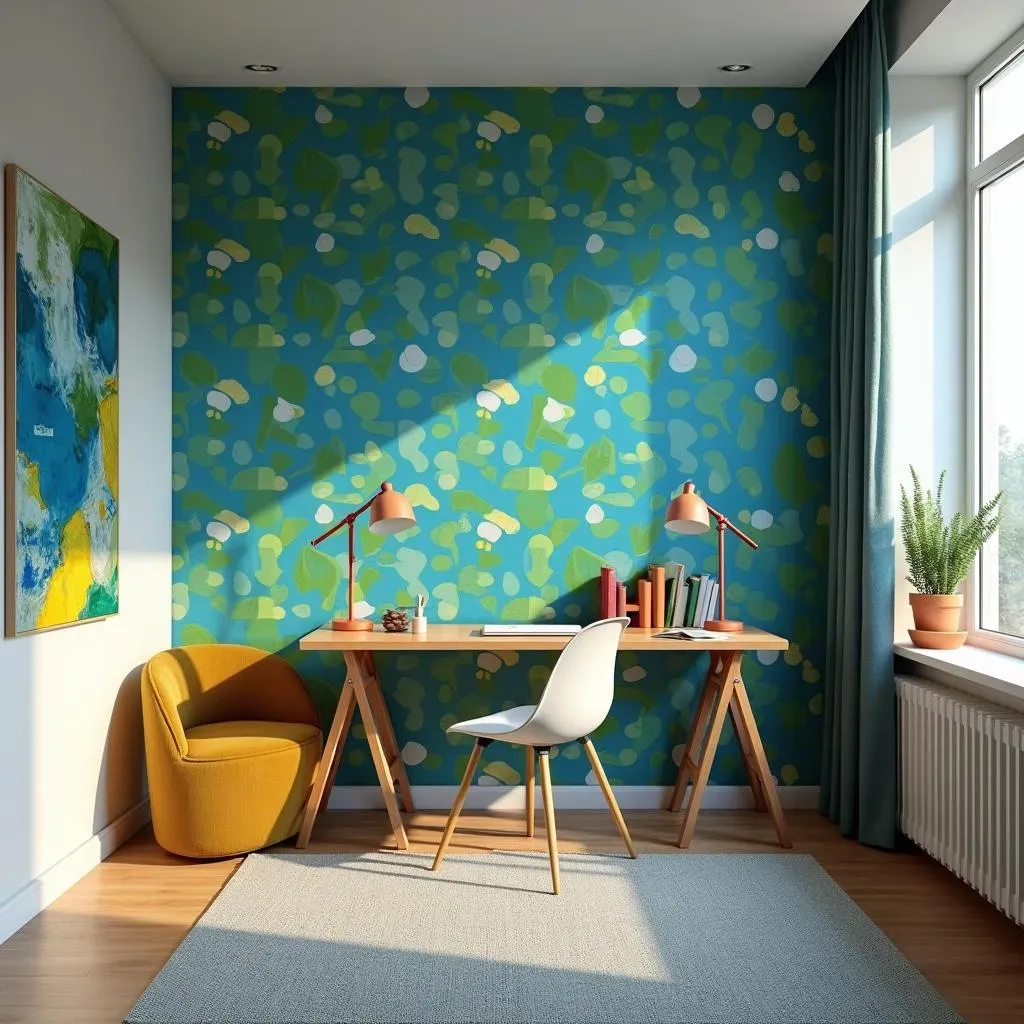Table of Contents
Is your home office feeling a little…blah? A home office wallpaper accent wall might be just the thing to inject some personality and boost your productivity. Forget staring at a blank, boring wall all day. We’re diving into the world of accent walls, exploring how a simple wallpaper change can transform your workspace from drab to fab. Think of it as a mini-makeover, a chance to express your style and create an environment that inspires you to crush your to-do list. Whether you're into bold geometric patterns, calming nature scenes, or sophisticated textures, there's a wallpaper out there to match your vibe. This article is your guide to understanding why an accent wall works, exploring a range of creative ideas, offering tips on how to choose the perfect wallpaper, and even providing some DIY installation advice. Get ready to say goodbye to that dull office and hello to a space that sparks joy and fuels your focus.
Why Choose a Home Office Wallpaper Accent Wall?

Why Choose a Home Office Wallpaper Accent Wall?
let's get real. Your home office is where you hustle, brainstorm, and maybe even take the occasional nap (don't lie!). So, Why Choose a Home Office Wallpaper Accent Wall? It's more than just aesthetics; it's about creating an environment that fuels your focus and sparks your creativity. A well-chosen accent wall can transform a sterile, uninspiring space into a haven of productivity. Think about it: staring at a blank wall all day can be mind-numbing. But add a pop of color, a cool pattern, or a textured design, and suddenly, you've got a visual focal point that keeps you engaged and motivated.
Beyond the visual appeal, a home office wallpaper accent wall can also help define your workspace, especially if you're working from a corner of your living room or bedroom. It creates a sense of separation, mentally carving out a dedicated zone for work. Plus, it's a relatively inexpensive and easy way to personalize your space and reflect your unique style. Let's be honest, who doesn't want a workspace that feels like *them*? It's about making your office a place you actually *want* to be, a place that inspires you to do your best work.
Benefit | Description |
|---|---|
Enhanced Focus | A visually stimulating accent wall can prevent boredom and keep you engaged. |
Defined Workspace | Creates a sense of separation, especially in multi-purpose rooms. |
Personalized Style | Reflects your taste and makes your office a place you enjoy being. |
Increased Productivity | A positive and inspiring environment can lead to better work output. |
Consider it an investment in your well-being and your career. A happy workspace equals a happy you, and a happy you equals better results. So, ditch the drab and embrace the power of the accent wall. Your productivity (and your sanity) will thank you for it.
Creative Home Office Wallpaper Accent Wall Ideas

Creative Home Office Wallpaper Accent Wall Ideas
Alright, let's dive into the fun part: creative home office wallpaper accent wall ideas! Forget boring beige – we're talking about transforming your workspace into a visual playground. First up, consider geometric patterns. Bold triangles, interlocking hexagons, or even a subtle chevron can add a modern, dynamic feel to your office. They're great for stimulating creativity and adding a touch of sophistication. If you're after something a bit more calming, nature-inspired wallpapers are a fantastic choice. Think lush tropical leaves, serene forest scenes, or even a subtle watercolor landscape. These can help create a relaxing and grounding atmosphere, perfect for those stressful deadlines.
For those who love a bit of texture, consider textured wallpapers. Grasscloth, faux brick, or even a subtle embossed pattern can add depth and visual interest to your accent wall without being overwhelming. These are great for creating a cozy and inviting space. And don't forget about color! A pop of bold color, like a vibrant teal or a sunny yellow, can instantly energize your office. Or, if you prefer something more subtle, a calming pastel or a sophisticated gray can create a more refined and professional look. The key is to choose a wallpaper that reflects your personality and complements your existing decor. After all, your home office should be a space that you love spending time in.
Wallpaper Style | Description | Best For |
|---|---|---|
Geometric Patterns | Bold shapes and lines. | Modern, dynamic workspaces. |
Nature-Inspired | Lush leaves, forests, landscapes. | Calming and grounding environments. |
Textured Wallpapers | Grasscloth, faux brick, embossed patterns. | Cozy and inviting spaces. |
Bold Colors | Vibrant teals, sunny yellows. | Energizing and stimulating offices. |
Think about adding a mural. A large-scale image can transport you to another place, sparking creativity and providing a welcome distraction when you need a mental break. Or, consider using removable wallpaper. This is a great option if you like to change things up frequently or if you're renting your space. It's easy to install and remove, without damaging your walls. Ultimately, the best home office wallpaper accent wall is one that makes you feel good and helps you do your best work.
Selecting the Perfect Wallpaper for Your Home Office Accent Wall

Selecting the Perfect Wallpaper for Your Home Office Accent Wall
Consider the Room's Size and Lighting
Alright, so you're ready to pick out the perfect wallpaper, huh? First things first: think about the size of your home office and how much natural light it gets. A small room can quickly feel cramped with a dark, busy pattern. Instead, opt for lighter colors and smaller-scale designs to create a sense of spaciousness. Think subtle textures or delicate floral prints. On the flip side, a large room can handle bolder patterns and darker hues without feeling overwhelming. If your office is blessed with tons of natural light, you can experiment with richer colors and more dramatic designs. But if it's a bit on the dimmer side, stick to lighter, brighter options to maximize the light you do have.
Also, consider the existing furniture and décor in your office. You want the wallpaper to complement your existing style, not clash with it. Are you rocking a modern, minimalist vibe? Then a geometric or abstract wallpaper might be a good fit. Or maybe you're more into a cozy, bohemian feel? Then a textured wallpaper or a nature-inspired print could be just what you need. The key is to create a cohesive look that reflects your personality and makes you feel good in your workspace.
Think About Color Psychology
Don't underestimate the power of color psychology! The colors you surround yourself with can have a significant impact on your mood and productivity. Blue is known for its calming and focus-enhancing properties, making it a great choice for a home office. Green is associated with nature and can help reduce stress and promote creativity. Yellow is energizing and uplifting, but too much can be overwhelming, so use it sparingly. Red is bold and stimulating, but it can also be agitating, so it's best to avoid it in a workspace. And neutral colors like gray and beige can create a sophisticated and calming backdrop, but they can also be a bit boring, so be sure to add some pops of color with your furniture and accessories.
Ultimately, the best color for your home office wallpaper accent wall is one that makes you feel good and helps you focus on your work. Experiment with different shades and tones to find what works best for you. And don't be afraid to step outside of your comfort zone and try something new. You might be surprised at what you discover!
Consider the Material and Texture
Beyond the pattern and color, the material and texture of your wallpaper can also have a big impact on the overall look and feel of your home office. Smooth wallpapers are easy to clean and maintain, making them a practical choice for a busy workspace. Textured wallpapers, like grasscloth or embossed vinyl, can add depth and visual interest to your accent wall. And specialty wallpapers, like metallic or flocked designs, can create a luxurious and sophisticated look. Also, consider the durability of the wallpaper. If you have kids or pets, you'll want to choose a wallpaper that can withstand some wear and tear. Vinyl wallpapers are a good option, as they're easy to clean and resistant to scratches and stains.
- Vinyl: Durable, easy to clean, good for high-traffic areas.
- Non-woven: Breathable, eco-friendly, easy to install.
- Grasscloth: Adds texture and warmth, natural look.
- Fabric: Luxurious, adds softness, requires professional installation.
Don't forget about the installation process! Some wallpapers are easier to install than others. Peel-and-stick wallpapers are a great option for DIYers, as they require no paste and are easy to remove. Traditional wallpapers require paste and can be a bit more challenging to install, but they offer a wider range of design options. If you're not comfortable installing wallpaper yourself, it's always best to hire a professional.
Selecting the Perfect Wallpaper for Your Home Office Accent Wall is a matter of balancing aesthetics, functionality, and personal preference. Take your time, do your research, and don't be afraid to experiment. With a little planning and effort, you can create an accent wall that transforms your home office into a space that inspires creativity and productivity.
DIY Tips and Tricks for Installing Your Home Office Wallpaper Accent Wall

DIY Tips and Tricks for Installing Your Home Office Wallpaper Accent Wall
Gather Your Supplies and Prep the Wall
Alright, so you've picked out your dream wallpaper – awesome! Now, before you even think about unrolling that beauty, let's talk prep. Trust me, proper preparation is the unsung hero of any successful wallpaper project. First, gather your supplies: you'll need a wallpaper smoothing tool (a plastic smoother works great), a utility knife with a sharp blade, a measuring tape, a level, a pencil, a bucket of clean water, a sponge, and wallpaper paste (if you're not using peel-and-stick). Oh, and don't forget a drop cloth to protect your floors!
Next up, inspect the wall. Is it smooth, clean, and dry? Any imperfections, like nail holes or cracks, need to be filled and sanded down. Wipe down the wall with a damp sponge to remove any dust or grime. If you're wallpapering over a painted surface, consider applying a wallpaper primer. This will help the wallpaper adhere better and prevent any peeling down the road. And finally, measure your wall! This will help you determine how much wallpaper you need and plan your cuts.
Pro Tip: If you're using a patterned wallpaper, make sure to account for pattern matching when calculating how much to buy. It's always better to have a little extra than to come up short!
Mastering the Art of Wallpaper Application
now for the main event: applying the wallpaper! If you're using peel-and-stick wallpaper, simply peel off the backing and carefully smooth it onto the wall, working from top to bottom. Use your smoothing tool to remove any air bubbles and ensure a smooth, even finish. If you're using traditional wallpaper, you'll need to apply wallpaper paste to the back of the paper. Follow the instructions on the paste container for the correct application method. Then, carefully align the wallpaper with the top of the wall and smooth it down, again working from top to bottom.
When it comes to trimming the edges, use your utility knife to carefully cut away any excess wallpaper along the top and bottom of the wall. Be sure to use a sharp blade for clean, precise cuts. And if you're working with a patterned wallpaper, take extra care to match the pattern at the seams. This might require a bit of trial and error, but the end result will be well worth it!
Step | Description | Tips |
|---|---|---|
1. Apply Paste | Evenly coat the back of the wallpaper with paste. | Avoid getting paste on the front. |
2. Align and Smooth | Carefully align the wallpaper and smooth from top to bottom. | Use a smoothing tool to remove air bubbles. |
3. Trim Edges | Use a sharp utility knife to trim excess wallpaper. | Keep the blade sharp for clean cuts. |
4. Match Patterns | Align patterns carefully at seams. | Take your time and be patient. |
Troubleshooting Common Wallpaper Problems
Let's face it, even the most experienced DIYers run into snags sometimes. Bubbles, seams, and misaligned patterns are all part of the wallpapering game. But don't panic! Most problems are easily fixable. For bubbles, try gently pricking them with a needle and smoothing out the air. For seams that aren't quite lining up, try gently nudging the wallpaper into place while the paste is still wet. And for stubborn stains or paste residue, try wiping them away with a damp sponge.
If you're really struggling, don't be afraid to call in a professional. Sometimes, it's worth the investment to ensure a flawless finish. But with a little patience, practice, and these DIY tips and tricks for installing your home office wallpaper accent wall, you can transform your workspace into a stylish and inspiring haven. Happy wallpapering!
Elevate Your Home Office with a Wallpaper Accent Wall
Ultimately, a home office wallpaper accent wall is more than just a design choice; it's an investment in your well-being and productivity. By carefully considering your personal style, the function of your workspace, and the practical aspects of wallpaper selection and installation, you can create a home office that is both inspiring and conducive to focused work. So, go ahead, embrace the power of wallpaper, and transform your home office into a space you truly love.
